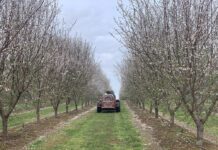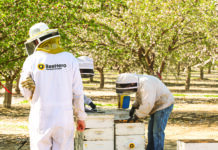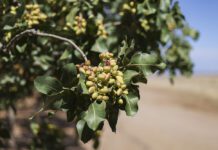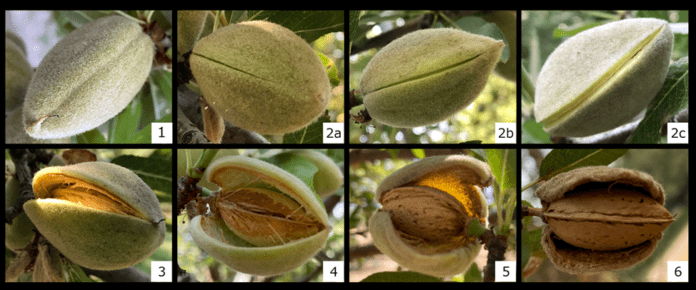
The almond crop subjective forecast is for a big crop (3 billion pounds), a 21% jump from 2023. With the crop potential set in each orchard, the focus is now on delivering the best quality crop possible with a tight budget. The good news is with good winter rains and clean surface water available, almonds are in a much better water situation than two years ago, so chances of good kernel size and reduced mite pressure are higher.
Almonds
Water
Careful attention to soil and/or tree moisture is critical for good nut growth while maintaining good root health (not too much root zone moisture). For growers with access to pressure chamber monitoring (the gold standard of irrigation management), the sweet spot for minimal water stress without excessive root zone moisture is one to two bars below baseline in early June. Sustained summer water stress reduces kernel size and risks higher mite pressure. During the second half of June, growers may want to consider changing irrigation practices ahead of hull split. Here’s an overview of an important practice that may (or may not) work for a particular grower.
Growers with the monitoring and irrigation system capacity/flexibility to micromanage irrigation can fine-tune irrigation to even up hull split and produce a timelier harvest. Sometimes called strategic deficit irrigation (SDI), this approach is worth considering but should be approached cautiously. The stakes are high. Underirrigation for long stretches during the summer can cost growers reduced kernel size at harvest. Not all growers, or even all orchards farmed by one grower, are a good fit for this practice. Please read The Almond Doctor’s great article on whether deficit irrigation is right for you.
In theory, this is how SDI works in mature bearing almonds. It’s a bit like driving through a tight turn; ease into it using the brakes while backing off on the gas, then return to cruising speed after making the turn. In this case, the ‘turn’ is the onset of hull split. At no time should irrigation stop during this process; stopping in a turn is asking for a wreck. Instead, irrigation should just be reduced while tree stress is monitored with a pressure chamber (or automated measuring device such as FloraPulse). In the second half of June, heading into hullsplit, easing from low (one to two bars below baseline) into mild stress (2 to 4 bars under baseline) can help the trees feather into hull split. Once hull split starts, further back off moisture to maintain moderate to high stress (14 to 18 bars; 2 to 10 bars below baseline depending on the weather) for just two weeks then increase irrigations to return orchard pressure chamber readings to no less than 2 to 4 bars below baseline (ease into hull split and return to cruising speed (low stress) heading toward harvest.) If the orchard is under moderate to high stress during nut drying (after hull split to shake), significant kernel size and income will be lost. Making this turn can help prep the orchard for a more uniform hull split, which is important in a year with heavy navel orangeworm (NOW) pressure, like this year…
Pests
Low crop quality in a low-price year is doubly painful. To help deliver a high-quality crop and get maximum possible income from what could be another low-price year, growers should pay particular attention to ant and NOW control. The two pests are really a package deal. For the best NOW management, ants need to be controlled, too.
The focus on delivering a high-quality crop doesn’t necessarily mean spending more money than in previous years, but it does mean making sure that what is done is done right. Harvest nuts at 100% hull split ahead of third-generation NOW egg laying. Get ant bait down on dry ground at proper timing. Get careful hull split sprays on early. Monitor carefully for spider mites and their predators.
The key to delivering the best-quality Nonpareil crop is harvesting before egg laying begins for the third generation of NOW, which should begin in early August about 1800 degree days after first biofix. Beating the third generation may mean shaking nuts earlier (greener) than would normally be done for growers focused on the inshell market, and this means longer drying time on the orchard floor. The longer nuts sit drying on the orchard floor, the more vulnerable they are to ant damage, and this is why ant control is key to NOW control (why go to all the hassle/cost of a timely harvest for NOW control when the nuts get chewed up by ants while drying?)
Monitor for protein-feeding ants. Ant baits are very effective, although application timing and control length vary with product. Depending on the bait product, application can be as early as six to eight weeks before harvest (shake) or just two weeks ahead of shaking. Ant baits work well as the protein-eating pest ants are attracted to the soybean oil in the product. But rancid soybean oil is not attractive to ants. Open bags of ant bait means rancid soybean oil in one to two weeks. For best results, use ant bait soon after purchasing. Don’t apply bait to wet ground as it will degrade. Wait 24 hours after irrigating to apply bait, and don’t apply within 48 hours before irrigation. Circle the calendar, put an alarm on your phone, but don’t let ant control (where needed) slip your mind as the rush of preharvest gets going.
Give ant baits enough time to work. For example, Clinch and Extinquish are 0 PHI materials but really do need to go on a full four weeks ahead of shaking so once in the ant nest the material acts on the whole population. Apply either of those products (or Esteem ant bait) too close to harvest and damage control will suffer. In comparison, Altrevin works fast but for shorter lengths of time.
Navel orangeworm: The best possible NOW management is achieved by practicing “the first and the last” program. The initial hull split spray should go on when the first sound (not blank) nuts just begin to split inside the orchard. These nuts are always in the tops of the trees. Earlier timing is better than later for NOW control. Timely harvest can start when the last of the nuts in the tree reach Stage 2C. This is when the hull can be “popped” open by squeezing the ends. The nuts close to the ground are the last to reach this stage. Shaking at 100% hull split before third-generation NOW egg laying should dramatically reduce damage compared with shaking after egg laying starts. The longer into the third generation shaking occurs, the more damage should be expected. Yes, more of the crop will need to be cracked out and inshell premium lost. However, it may be clean meats pay more than wormy inshell deliveries. Now, June, is the time to talk with your processor and PCA about delivery options and the steps needed to get the best results.
Hull split insecticide sprays protect the new crop from NOW. Complete control is not possible, but spraying can reduce damage at least 50% when done properly. Spray practices that improve control in dense, heavily cropped orchards include slow tractor speed (more time for the sprayer fan to move spray throughout the tree), higher spray volume (150 to 200 gallons per acre) and night spraying (less spray evaporation). These are proven practices. Longer residual products such as Intrepid or Altacor provide the best control from hull split to harvest without flaring mites. The first spray should go on at the earliest sign of splitting of sound nuts and then as quickly as possible. The target nuts of the first spray are in the tree tops, where aerial application can deliver good coverage.
Mating disruption (MD), when applied as a season-long program, reduces NOW damage by 50%. In a high-pressure year, MD will pay for itself when processor insect damage reports are 1% or more. While sprayable NOW pheromone is commercially available, in UC research, the puffers and rubber strip products have been the effective treatments.
Don’t forget spider mites in the focus on NOW and ants. Continue to monitor spider mite populations and their predators. New information on monitoring six-spotted thrips, the new key predator for spider mites, is available. Given the good water situation in many orchards, a good predator population may mean miticide application at hull split is not needed. This decision must be made on a block-by-block basis.
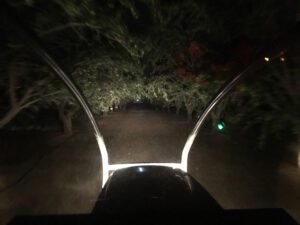
Stink bugs can be another source of crop quality loss. “Brown spot” off grade is caused by bug feeding after shell hardening. Talk with your PCA about scouting options. The only effective control for stink bugs is pyrethroids, so know for sure a problem exists before using this disruptive (but effective) insecticide. Not all stinkbugs cause damage.
Disease: The key timing for hull rot (Rhizopus; black bread mold) management matches with the first hull split timing for NOW. Talk with your PCA about materials and rates if a particular orchard has a history of hull rot or if humidity levels indicate the chance for increased hull rot. See the UC IPM publication on Fungicide Efficacy and Timing for additional information.
Nutrition
By June 1, nitrogen use by the crop is tailing off while potassium demand is still steady. A quick leaf sample will show the relative N and K status of the orchard ahead of the usual July sampling window. If leaf levels are below what is “adequate” in July, some additional fertilizer may be advisable. For N, any extra should be balanced with hull rot concerns.
Harvest
Shaking is still a couple months away, but there is value in planning ahead for harvest. A preharvest checkup with an experienced mechanic/technician may avoid costly breakdowns during crunch time later this summer.
Planning
Mark your calendar for 1) leaf sampling in July, 2) nut quality sampling when the nuts are drying (just before windrowing) and 3) hull samples for boron from the windrows just before pickup.
Walnuts
Irrigate and fertilize to maintain orchard and crop health wherever possible. Use a pressure chamber to manage irrigation without excessive water. Deficit irrigation in walnut is not advisable, but neither is overirrigation. June is the second month of the 25-25-25-25 program for N fertilization of walnut. One quarter of the orchard N need should be applied in June.
Husk fly traps should be up by June 1. Codling moth traps and mite management should be monitored weekly. I’m hearing reports of elevated early codling moth trap catches. Also, given the nut price, walnuts are a good place to utilize biological control for spider mites. See the link for six-spotted thrips monitoring in the references.
All the best as the summer sets in.
Resources
Subjective almond forecast: nass.usda.gov/Statistics_by_State/California/Publications/Specialty_and_Other_Releases/Almond/
Irrigation:
Pressure chamber
What is baseline? youtube.com/watch?v=F1xwJVAyQ3A
sacvalleyorchards.com/manuals/stem-water-potential/advanced-swp-interpretation-in-almond/
Using the pressure chamber for nuts and prunes: anrcatalog.ucanr.edu/Details.aspx?itemNo=8503#FullDescription
The Almond Doctor
thealmonddoctor.com/regulated-deficit-irrigation-application/
thealmonddoctor.com/irrigating-almonds-through-the-summer/
Pests:
Ants: ipm.ucanr.edu/agriculture/almond/ants/
Spider mites: ipm.ucanr.edu/agriculture/almond/webspinning-spider-mites
Monitoring six-spotted thrips for mite managing: youtube.com/watch?v=ufJ4VCa-IFI
Navel orangeworm: ipm.ucanr.edu/agriculture/almond/navel-orangeworm/
Brown Marmorated Stink Bug: youtube.com/watch?v=fc2qv7YtaWU
Fungicide efficiacy and timing (at the bottom of the page): ipm.ucanr.edu/agriculture/
Harvest timing: sacvalleyorchards.com/blog/almonds-blog/when-do-you-shake/







